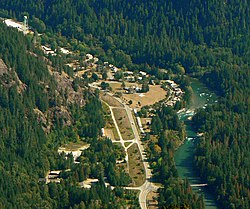Skagit River
The Skagit River is a river in Canada and the United States. It flows about 120 miles (190 km) from British Columbia to the state of Washington, where it flows into the Pacific Ocean north of Seattle. The river begins by flowing south. It then enters North Cascades National Park, where it is dammed by Ross Dam, which forms Ross Lake, a reservoir. [1]
Geography
The river then leaves the lake and flows into Diablo Lake, also a reservoir. It then keeps flowing southwest through a deep river canyon, known as the Skagit Gorge. It then meets its largest tributary, the Sauk River, and then turns west. The Sauk is about 45 miles long, flowing northwest.
After turing west, the Skagit parallels the North Cascades Highway, leaving the national park. It meets another tributary, the Baker River, from the north. The Baker flows south about 30 miles and is dammed twice, in Baker Lake and Lake Shannon. The river then flows out to the sea near Mount Vernon, Washington. The total extent of the basin is 1,505 square miles (3,900 square kilometers).
Skagit River Media
The Skagit River Delta is an important winter habitat for snow geese (pictured) and trumpeter swans
The Skagit River near Marblemount, Washington
Looking upstream from 26 Mile Bridge in British Columbia, Canada
Aerial view of the Skagit River at Burlington and Mount Vernon
References
- ↑ "Fifty Years of Wild and Scenic Rivers in Washington: The Skagit River and Illabot Creek". American Rivers. 2019-02-12. Retrieved 2020-07-17.







